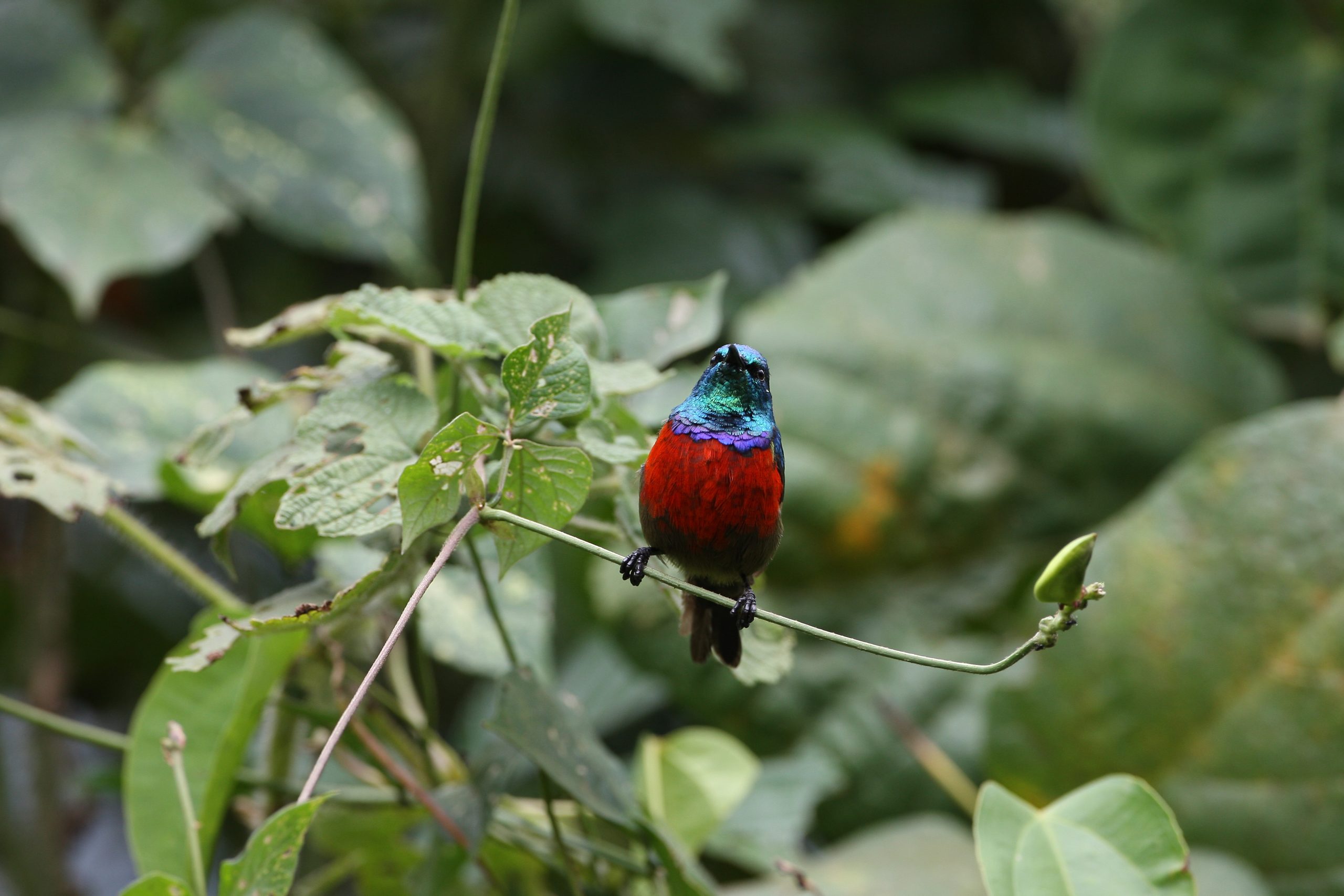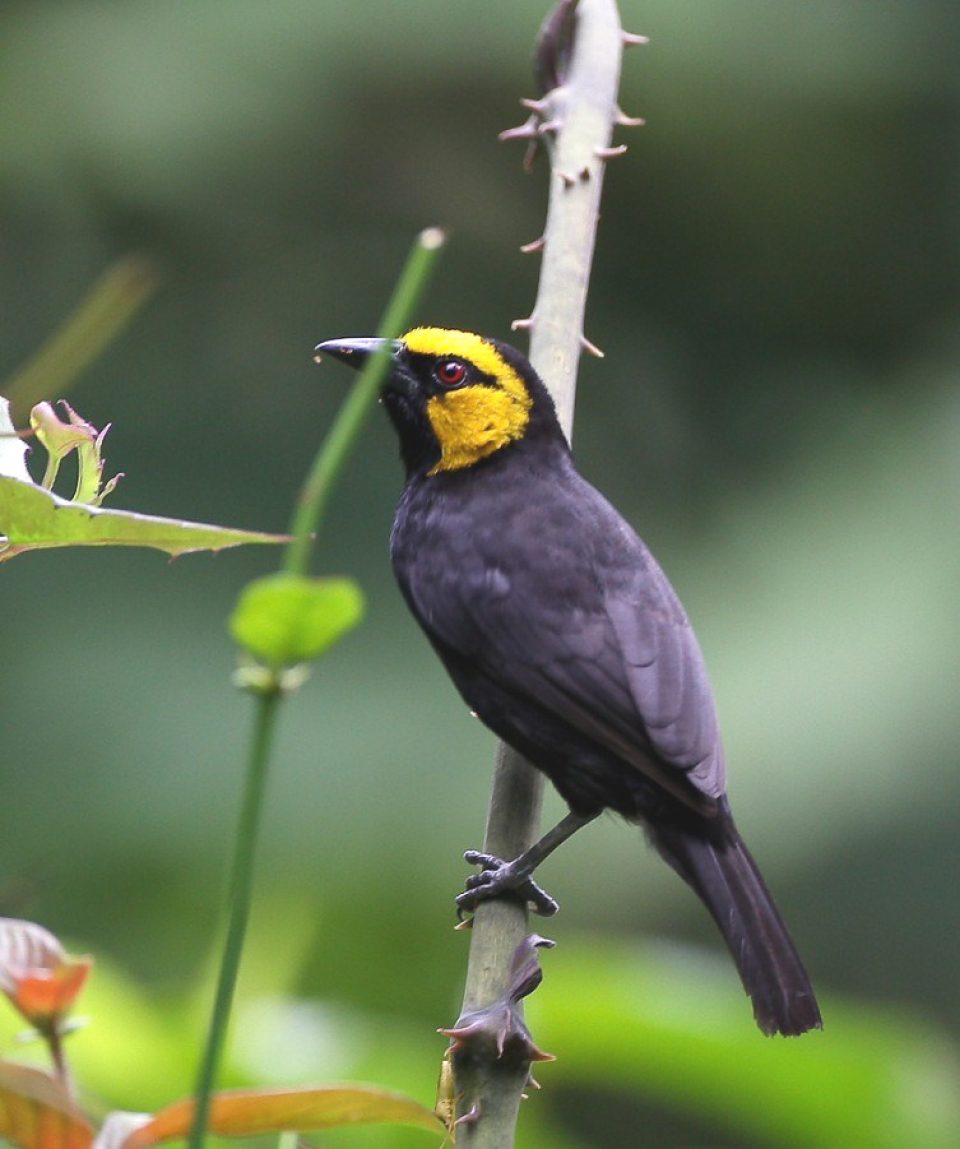18 Days Uganda Birding and Gorilla trekking Safari
from18 Days Uganda Birding and Gorilla t trekking Safari indulges you to a home to many primates in Kibale National Park, Bwindi Impenetrable National Park, Uganda Safari destinations that offer amazing primate trekking Safari experiences. With Uganda Savannah parks being a hotspot for game drives in a savannah environment with plenty of lion, buffalo and elephant, as well as a range of antelope species. The country is particularly scenic and has a lot to offer to people with a keen interest in natural history and who enjoy active holidays.
-
Reviews 0 Reviews0/5
-
Vacation Style Holiday Type
-
Activity Level Fairly Easy
-
Group Size Medium Group
18 Days Uganda Birding and Gorilla t trekking Safari will take you from the Swamps of Mabamba to look for the Shoebill, to the devil’s cauldron in Murchison falls National Park. From here, you will go west to the home of our closely related cousins, the Chimpanzee in Kibale National Park, then south to the home of the tree-climbing lions in Queen Elizabeth National Park. This shall be followed by
Penetrating the impenetrable forest of Bwindi that is home to the Mountain Gorilla and the Albertine rift endemics, which shall be climaxed by the low savannah plains of Lake Mburo National Park where special species like the Tabora Cisticola, and the Red-faced Barbet can be seen.
Key Points
Wildlife Experience, Shoe bill, Mountain Gorillas Trekking, Chimpanzees Trekking
Day 1: Arrival
Arrival at Entebbe Airport and transfer to Boma hotel for the night.
Day 2: Birding Mabamba Swamp and afternoon transfer to Murchison Falls National Park
After an early breakfast, we drive to Mabamba Swamp, 50 km west of Kampala. Stop en route at Mpigi Swamp for papyrus rarities. Look out for; the White-winged Warbler, Papyrus Gonolek, Yellow-backed Weaver, Northern Brown-throated Weaver, Blue-headed Coucal, and other swamp specialties.
We continue to the Mabamba Wetland as we proceed on our 18 Days Uganda Birding and Gorilla t trekking Safari . At the Swamp, most of the birding is done on a canoe, paddled by our local site guides. Watch out for the Shoebill both in the sky and down in the marsh. Also watch out for the; Swamp Flycatcher, African Purple Swamp Hen, African Water Rail, Common Moorhen, Lesser Jacana, African Jacana, African Pigmy Goose, White-faced Whistling Duck, Squacco Heron, Blue-breasted Bee-eater, Winding Cisticola, Goliath Heron, and Black Crake.
In the afternoon, we bird to Murchison Falls National Park. Murchison Falls National Park is Uganda’s largest National Park (3893sq.km) and it protects a huge chunk of untamed savannah bisected by the mighty River Nile. Today it is part of the even much larger Murchison Falls Protected Area (5072sq.km) which includes the adjoining Karuma and Bugungu Wildlife Reserves. It is named for the dramatic Murchison Falls whereby the World’s longest river explodes violently through a narrow cleft in the Rift Valley escarpment to plunge in a frothing pool 43 m below. It is one of Uganda’s oldest conservation areas; it was initially gazetted as a game reserve in 1926 to protect a savannah that Winston Churchill described in 1907 as ‘Kew Gardens and the Zoo combined on an unlimited scale. The park has 76 mammal species including the lion, elephant, leopard, hippopotamus, Rothschild giraffe, Cape buffalo, hartebeest, oribi, warthog, and the Uganda Kob. The park also hosts 360 bird species including the rare Shoebill Stork.
Stay at Paraa Safari Lodge
Day 3 to 4: Birding, Game Drives and Afternoon Launch Trip
After breakfast, we have a game drive to the rolling plains where you will have chances of viewing Hartebeest, Lions, Buffalo, Primates, Mongoose, Giraffe and Elephants. After lunch, we will have an afternoon launch cruise where you have chances to view huge Nile Crocodiles, big Pods of Hippos, and other wildlife. You will also be able to see a wide variety of water birds like the Shoebill, Secretary Bird, Abyssinian Roller and Ground Hornbill, Pied Kingfishers and many more.
Nights at Paraa Safari Lodge.
Day 5: Birding to Masindi – 18 Days Uganda Birding and Gorilla t trekking Safari
En route to Masindi, we will pass through lots of wild country with an open palm savanna, unlike any other in East Africa, and along the way we may find birds like Abyssinian Ground Hornbill, Senegal Lapwing, White-rumped Seedeater, and the weird Piapiac. We will stop at the Butiaba escarpment. Although it’s not far from the Budongo rainforest, it holds completely different arid savanna landscapes, and species like Mocking Cliff-Chat, Foxy Cisticola, and Brown Babbler.
Day 6: Birding in Budongo Forest-Royal Mile and Busingiro Section
Stay at Masindi Hotel
We bird Budongo’s famous Royal Mile in the earl morning. It is a wide forestry track considered by many to be the country’s premier forest birding locality. This is the best place in Uganda for Nahan’s Francolin, Cassin’s Spinetail, and Chestnut-capped Flycatcher. There are many confusing forest Greenbuls to test us including Spotted, Xavier’s, White-throated, Red-tailed and Honeyguide Greenbuls. Canopy flocks support Yellow-mantled Weaver, Rufous Thrush and Uganda Woodland Warbler. The undergrowth along the track holds numerous skulkers including Scaly-breasted, Brown and Pale-breasted Illadopses, Fire-crested Alethe, Blue-shouldered Robin-Chat, Rufous Flycatcher-Thrush, Red-tailed Ant-Thrush, Yellow-browed Camaroptera, Yellow Long-bill, and Grey-throated Tit-Flycatcher. We will keep an eye on any openings in the forest canopy such as Cassin’s and Crowned Hawk Eagles, Cassin’s and Sabine’s Spine-tails, and White-throated Bee-eaters are all possible. The area around the Park Headquarters is the only site in East Africa for the elusive canopy dwelling Ituri Batis.
Stay at Masindi Hotel
Day 7: Birding to Kibale National Park
After breakfast, we will drive to Kibale forest arriving in Fort Portal in the late afternoon. Kibale forest national park is the best safari destination for chimpanzee tracking in East Africa. It contains one of the loveliest and most varied tracts of all tropical forests in Uganda. It hosts 13 species of primates including the Chimpanzee. It has 1450 chimpanzees, and these represent Uganda’s largest population of this endangered primate. It is also home to the rare L’hoest’s Monkey and East Africa’s largest population of the threatened Red Colobus Monkey.
Other primates that you may see include the Black and White Colobus, Blue Monkey, Grey-cheeked Mangabey, Red-tailed Monkey, Olive Baboon, Bush baby and Pottos. Kibale forest cover predominates in the Northern and Central parts of the park. Kibale is highest at the park’s Northern tip which stands at 1590m above sea level. The park also boasts 325 bird species, including 6 that are endemic to the Albertine Rift region. They include the Black capped Apalis, Blue-headed Sunbird, Collared Apalis, Dusky Crimsonwing, Purple-breasted Sunbird and Red-faced Woodland Warbler. If you are lucky, you may also see the African Pitta, Green-breasted Pitta, Black Bee-eater, Yellow-spotted Nicator, Yellow-rumped Tinkerbird, Little Greenbul, Black-eared Ground-Thrush, Brown-chested Alethe, Blue-breasted Kingfisher, Abyssinian Ground-Thrush, and the Crowned Eagle.
Overnight at Primate Lodge Primate
Day 8: Chimpanzee tracking in the forest – Uganda
After an early breakfast we drive to Kibale National Park visitor center for briefing and chimp tracking. The activity may last from a few hours to several hours. Kibale forest is home to 13 primates of Uganda.
Birding in the afternoon along the main road may be productive. Depending on the weather predictions, birding Bigodi wetland is also productive with riverine forest birds. Kibale National Park is a good site for a number of birds that are hard to find elsewhere including; the Speckle-breasted Woodpecker, Cabanis’s Greenbul and Joyful Greenbul as well as White-spotted Flufftail, Dusky and Olive Long-tailed Cuckoos, Lesser Honey guide, Blue-shouldered Robin-Chat, White-chinned Prinia, Grey Apalis, Olive-green Camaroptera and White-collared Oliveback.
Stay at Primate Lodge Kibale
Day 9: Birding to Queen Elizabeth National Park
After breakfast, we drive to Queen Elizabeth national park. The Park which is named after the Queen of England who visited it in 1954 is the second largest national park in Uganda. Queen Elizabeth national park boasts the highest biodiversity ratings of any game reserve in the world. This is evidenced by the presence of open savannah, rainforest, dense papyrus swamps and brooding crater lakes, and the vast Lake Edward. Queen Elizabeth National Park has almost 100 mammal species and a remarkable 612 bird species hence making it a superb safari territory, with elephants, a profusion of hippos, the elusive Giant Forest hog and handsome Uganda Kob all regularly sighted around the tourist village on the Mweya Peninsula – which also boasts a marvelous waterfront setting in the shadow of the Rwenzori Mountains.
Stay at Bush Lodge.
Day 10: Game drive and afternoon boat cruise on the Kazinga Channel
There will be a morning game drive searching for; Lions, Elephants, Buffaloes, Uganda Kobs, Waterbucks, Warthorgs and many more. After lunch, you have an exotic and exciting launch trip on the Kazinga Channel. The launch trip is one of the most exciting water activities in Uganda. The Kazinga channel is a narrow neck of water that connects Lakes George and Edward, with excellent photographic opportunities for waterside birds and abundant Hippopotamus, huge families of buffalos, and elephants. And you are likely to encounter some bird species as well.
Stay at Bush Lodge.
Day 11: Travel to Bwindi Forest National Park
You start early after breakfast, we will also drive through the Ishasha section where, if lucky, you may be able to view tree climbing lions and continue to Bwindi Impenetrable National Park. Bwindi Park is a UNESCO World Heritage Site and is home to approximately half of the world endangered population of Mountain Gorillas. This vast reserve offers arguably the most productive montane forest birding in Africa and supports 23 of Uganda’s 24 Albertine Rift endemic bird species. Once part of a much larger forest that included the Virunga Volcanoes in neighbouring Rwanda, Bwindi Impenetrable National Park is now an ecological island within a sea of human cultivation and therefore of big conservation importance.
Forest birding in Bwindi ranks the best in Uganda. It is home to 23 highly localized Albertine Rift Endemics. Special birds include; Black-faced Rufous Warbler, Grauer’s Warbler, Banded Prinia, Black-throated Apalis, Mountain Masked Apalis, Red-throated Alethe, Yellow-eyed Black Flycatcher, Ashy Flycatcher, Dusky-blue Flycatcher, Chapin’s Flycatcher, Chin-spot Batis, Rwenzori Batis, Black-and-white-Shrike-flycatcher, Yellow-bellied Waxbill, Magpie Mannikin, Yellow-crowned Canary, Thick-billed Seed-eater, Streaky Seedeater, African Green Broadbill, Shelly’s Crimsonwing, Oriole Finch, Mountain Buzzard, Ayre’s Hawk Eagle, Handsome Francolin, Black-billed Turaco, Barred Long-tailed Cuckoo, African Wood Owl, Rwenzori Nightjar, Scarce Swift, Bar-tailed Trogon, Cinnamon-chested Bee-eater, Black Bee-eater, Western Bronze-naped Pigeon, Red-chested Owlet, Tullberg’s Woodpecker, Elliot’s Woodpecker, African Broadbill, Western Green Tinkerbird, African Green Broadbill, Lagden’s Bush Shrike, Petit’s Cuckoo Shrike, Grey Cuckoo Shrike, Archer’s Ground Robin, Toro Olive Greenbul, Ansorge’s Greenbul, Equatorial Akalat, White-bellied Robin-Chat, Olive Thrush, White-tailed Ant Thrush, Grauer’s Rush Warbler, Short-tailed Warbler, Neumann’s Warbler, and Red-faced Woodland Warbler to mention but a few.
Stay at Buhoma-Ride 4 a woman.
Day 12: Gorilla Tracking
After breakfast, we shall assemble at the Park Offices for the briefing prior to this historic event. Gorilla tracking is a very captivating activity; it might take 1-8 hours which involves walking in the wilderness in search of these gentle giants. Gorilla Tracking can be a challenging activity, therefore ensure physical fitness. Eight people are permitted per group per day. On occasions the Gorillas prove elusive but often can be found within an hour by the tracker guides. It is a wonderful experience to stare in to the eyes of these gentle giants; watch them in awe as they play and go about their daily activities. Gorilla Tracking is indeed a “once in a lifetime” experience that you must never miss. Each encounter with the gorillas is different and has its own rewards, but you are likely to enjoy the close view of adults feeding, grooming and resting as the youngsters frolic and swing from vines in a delightfully playful display.
Overnight at Ride 4 a woman.
Day 13: Buhoma Village walk
After Breakfast, we have a village walk around the Buhoma Community. We will visit the Batwa and you will observe their ways of living. The Batwa were given land upon relocation from the forest and most of their basic needs are taken care of. The money they receive out of the village walk is, therefore, used to buy clothes and food. They also use the money from sale of crafts for recreational purposes, reading and buying of alcohol. You will also observe how they go about the process of juice making. We will also visit the traditional healer and you will observe how he treats ailments using tree bark, leaves, and some animal material. He dresses in goat and cow skin to preserve the way traditional healers used to dress. You will also be taken through tea plantations and 10 sites that describe the way of life of the Buhoma Community. NOTE: However there is an optional to bird watching in the forest.
Stay at Ride 4 a woman
Day 14:vBirding to Ruhija
After breakfast, we head to Ruhija sector of Bwindi National Park. Along the way, we’ll pass through “The Neck”, a narrow strip of forest that connects the southern and northern portions of the national park. This forest system is the eastern extension of the vast Congo forests combined with a series of restricted range species of the Albertine Rift. This forest which extends into the DR Congo, is far more accessible and very safe to visit, making this the perfect area for birders to see a range of species that are otherwise logistically very difficult to see. Here we have a chance to find some specialties, which include Cassin’s Flycatcher, Black Bee-eater, African Black Duck, White-browed Crombec, Western Bronze-naped Pigeon, Barred Long-tailed Cuckoo, and many more.
Stay at Trekkers Tarven
Day 15: Birding Mubwindi Swamp
We spend the entire day birding the Mubwindi Swamp area. The 4 km trail to Mubwindi Swamp is the best place for some of the most difficult to find of all rift endemics. This includes Grauer’s (African Green) Broadbill, the beautiful Regal Sunbird, and Archer’s Robin-Chat. Mubwindi Swamp is also home to Dwarf Honeyguide, Stripe-breasted Tit, and Ruwenzori Apalis. African Hill Babbler (sometimes treated as a separate species from Ruwenzori Hill Babbler), the rare and localized Grauer’s Scrub-Warbler. Some of the many species we have a chance of seeing here include Black Goshawk, Augur Buzzard, Crowned Hawk-Eagle, and Handsome Francolin. Olive (Rameron) Pigeon, Bronze-winged Pigeon, Black-billed, Ruwenzori, and Ross’s Turaco, Barred Long-tailed, and African Emerald Cuckoos. Red-chested Owlet, Narina and Bar-tailed Trogons, Black and Cinnamon-chested Bee-eaters, Blue-throated Roller. White-headed Woodhoopoe, Grey-throated, Double-toothed, and Yellow-spotted Barbets, Western and Yellow-rumped Tinkerbird, Thick-billed and Dwarf Honeyguides. Rufous-necked Wryneck, Tullberg’s, Speckle-breasted, Elliot’s, and Olive Woodpeckers, African Broadbill, Rock Martin, Black Saw-wing. Gray and Petit’s Cuckoo-Shrike, Ansorge’s, Kakamega and Cabanis’ Greenbuls, White-tailed Ant-Thrush, Abyssinian Ground-Thrush, Olive and Mountain Thrushes, Red-throated Alethe, Chubb’s Cisticola. Banded Prinia, Ruwenzori, Black-throated, and Black-faced Apalis, Olive-green Camaroptera, Grauer’s Warbler, Cinnamon Bracken-Warblers, Mountain Yellow Warbler and Black-faced Rufous Warblers. White-browed Crombec, Short-tailed Warbler, Red-faced Woodland-Warbler, White-eyed Slaty-Flycatcher, Yellow-eyed Black-Flycatcher, Sooty Flycatcher, Chapin’s Flycatcher. White-starred Robin, White-bellied and Archer’s Robin-Chats, Rwenzori Batis, White-tailed, and African Blue-Flycatchers, Pale-breasted, Mountain, and Gray-chested Illadopsis. Ruwenzori Hill Babbler, Gray-headed, Western Violet-backed, Green, Green-headed, Blue-headed, Green-throated, Stuhlmann’s, Northern Double-collared, and Regal Sunbirds, Mackinnon’s Shrike. Lühder’s, Gray-green, Many-coloured, and Lagden’s Bush-shrikes, Velvet-mantled Drongo, Slender-billed, Waller’s, Narrow-tailed, Stuhlmann’s, and Sharpe’s Starlings. Black-billed, Strange, and Brown-capped Weavers, Jameson’s Ant-pecker, and Red-faced and Dusky Crimson-wings.
Stay at Trekkers Tarven
Day 16: Birding to Lake Mburo National Park
Lake Mburo national park is a gem of a park. Though the park is just 370 sq km in size, its landscapes are varied and even a short drive is alive with interest and color. You will pass gallery forests, open savannah and acacia woodland, rocky kopjes, seasonal and permanent swamps, and open water as you search for the wealth of wildlife they support. A variety of vegetative habitats surround the open water of Lake Mburo. The lake’s western side is dominated by a grassy escarpment rising above a shoreline fringed with acacia forest and the closed canopy Rubanga Forest. To the north and east, grassy valley floors, made seasonally lush and soggy by rain, drain between undulating hills. These seep through expanses of wetland into the lake. Rock Kopjes are found along the eastern margins of the park. These varied habitats support an impressive variety of wildlife including 68 mammal species. These include some rarities.
Lake Mburo national park is the only park in Uganda to contain Impala and the only one in the rift region to host Burchell’s Zebra and Eland. In Uganda, Topi are only found in Lake Mburo and Queen Elizabeth national parks. Common wildlife species include warthog, buffalo, oribi, Deffassa Water buck and reedbuck. Leopard and hyena are also present while hippo and crocodile are found in the lake.
Common conspicuous birds we will encounter on our journey to Lake Mburo include; Crested Francolin, Emerald Spotted Wood Dove, Brown Parrot, Bare-faced Go-away Bird, Blue-napped Mousebird, Lilac-breasted Roller, Green Wood hoopoe, Common Scimitar Bill, African Grey Hornbill, Spot-flanked Barbet, Nubian Woodpecker, Trilling Cisticola, Yellow-breasted Apalis, Northern Black Tit, Chin-spot Batis, Greater Blue-eared Starling, and Marico Sunbird. The woodland in the immediate vicinity of Rwonyo also supports many of these widespread species.
Stay at Rwakobo Rock
Day 16: Whole day Birding and game drive in the park
After breakfast, we will have a morning game drive in the park looking for mammals including Zebras, Impalas, Elands, Topi and Buffaloes. In the afternoon, we will have a boat trip looking for bird specialties and other mammals in the park.
Stay at Rwakobo Rock.
Day 18: Transfer to Entebbe for departure
Birding to Entebbe Airport for departures passing via the Equator for Photos and lunch stop or craft shopping for souvenirs, depending on your flight we might have a guest room for refreshing before we could head to the check in at the airport.



